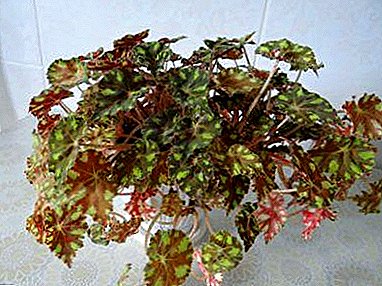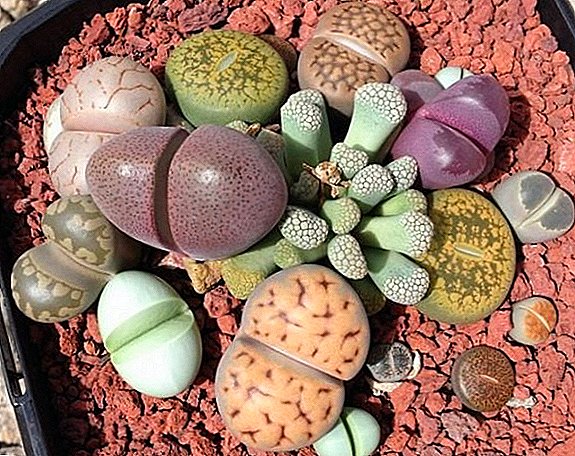 Lithops are succulent plants from the family of the Aizoids. Lithops formed by two fleshy sheets accreted at the base, without a doubt, is able to decorate any home oasis, becoming its highlight. This is largely determined by the popularity of this exotic plant and a myriad of people who want to grow a flower, like a stone, at home.
Lithops are succulent plants from the family of the Aizoids. Lithops formed by two fleshy sheets accreted at the base, without a doubt, is able to decorate any home oasis, becoming its highlight. This is largely determined by the popularity of this exotic plant and a myriad of people who want to grow a flower, like a stone, at home.
Did you know? Translated from the Greek word "Lithops" translates as "similar to the stone" ("like a stone"), which really fully conveys the essence and appearance of the plant.
How to choose a Lithops when buying
Before going to a specialty store for such an exotic plant, it is advisable to learn what Lithops are and what type they are. The reason is simple: using the ignorance of people, unscrupulous sellers often give out ordinary dwarf cacti for lithops.
When buying, you should carefully examine the entire surface of the plant for the presence of any spots, traces of mold and rot, as well as mechanical damage. Even small pockets and scratches in the future can be destructive, so it is better not to buy Lithops with similar defects.
The degree of development of the root system also needs to be checked before purchase. Fortunately, it is quite simple to do this - you need to slightly swing the plant and assess the condition of the shoots on the surface. They must be strong and move away from the leaves not less than 2-3 cm in radius (for young shoots).
It is also necessary to lightly touch the surface of the leaves of Lithops. Its softened structure indicates the beginning of rotting, that is, a complete violation of the prescribed conditions of detention. Shopping such "blooming stones" should be avoided.

What conditions to create for growing lithops in the house
According to the reviews of experts and experienced flower growers, Lithops are unpretentious, however, as for any other home plant, it is imperative to create optimal conditions for the “blooming live rock”. For this purpose, it is necessary to properly place the pot with the plant, to provide it with proper lighting and temperature control.
Location and lighting
The most important factor in the home maintenance of a “living stone” is its location and lighting. In the wild, lithops grow exclusively in open sunny areas, so the plant should receive enough natural light at home. For "blooming stones" is better suited to the place in the house where the sun's rays fall within three to four hours a day.
Experts recommend putting a pot with Lithops to the south or west windows in the house, and as close as possible to the glass (so that the sun's rays do not refract). In winter, when natural lighting becomes significantly less, it should be compensated by installing over the "living stones" artificial lighting. As a rule, fluorescent lamps are best suited. The height of their fixing is from 10 to 15 cm (depending on the power of the lamp and the size of the lithops).
Did you know? Modern craftsmen and lovers of this plant often practice the option of automated creation of lighting conditions. For this, a pot with lithops is placed under a fluorescent lamp, and it, in turn, is connected to a controlled regulator. - it turns on the lamp during the day and turns it off at night. This greatly simplifies the process of home cultivation.

Temperature
Due to its nature, this exotic plant is much better. tolerates dry weatherrather than freezing. Moreover, Lithops very sensitively react to a decrease in atmospheric pressure.
In the spring-summer period, when the root system of "live stones" actively grows, the temperature of their home maintenance should vary within + 20 ... +25 ° С. In the autumn-winter period, when flowering does not occur, the pot with lithops should be kept at + 12 ... +15 ° С.
It is noteworthy that an adult plant, like small shoots, loves temperature drops, so in the summer period it is desirable to change the temperature of the content from +25 ° C during the day to +15 ° C at night. To do this, simply move the pot from the windowsill to the floor. In winter and during the rest period, such procedures are not required.
Did you know? Homeland Lithops are hot deserts of South Africa: Namibia, Botswana, South Africa. The climate of these regions is rather harsh and monotonous, since the total absence of life-giving moisture is aggravated by the fact that any precipitations also do not fall out, and the heat reaches +50 ° C. Such conditions are optimal for the growth of Lithops in a wild environment. However, for home cultivation should be created softer, benign conditions.

How to care for the "living stone" at home
Along with the unusual appearance of "living stone", many people are attracted by its unpretentiousness, as well as the fact that even at home you can productively grow lithops, which care and maintenance boils down to timely and sufficient watering, proper placement of the pot with the plant and correct feeding. blooming stone. "
Watering
Despite the fact that the lithops can quite easily transfer some lack of moisture, getting it from the reserves in the leaves, excessive watering and stagnant water, as a rule, quickly lead to the destruction, weakening and rotting of the roots. Therefore, you should correctly determine the mode of watering.
Succulent plants also include cacti, which are in harmony with the Lithops in the compositions. For cacti to look beautiful, they need the right care, protection from diseases and pests.
So, from mid-spring to late autumn, Lithops require watering every 7-10 days. It is important to pay attention to the condition of the plant - if the incoming moisture is not enough, then in the daytime the leaves will shrink. In case of such situations, the frequency of watering should be increased.
On particularly hot and dry days, care for the “living stones” should change: in addition to the main irrigation, every evening the Lithops leaves should be sprinkled with warm water. At that moment, when the plant is preparing to change the leaves or the formation of buds, watering increase. Together with irrigation at this time you can make some mineral fertilizers, spreading them in water.

With the beginning of the dormant period, which falls on the winter, watering should be stopped. It is desirable to restore it only in February, and the regularity and volume of watering should be reduced. So, it is quite enough to moisten the soil in the pot with a sprayer every 2-3 weeks. The frequency of irrigation should be increased only if the opening of the gap between the leaves of "living stones" is delayed.
During watering, it is strongly recommended to avoid direct ingress of moisture into the gap formed by the leaves, and not to leave it on the side surfaces of "live rock". This can cause severe sunburn and tissue rotting.
It is noteworthy that with regular moderate watering, it is permissible once every 1-2 months to pour a plant pot abundantly, imitating the natural rainy season. In general, it favorably affects the development of the root system.
It should be understood that it is watering that predetermines not only the viability of lithops at home, but also its appearance. So, with an excess of incoming water, it accumulates in the old, outdated leaves, as a result of which they do not die off, which significantly worsens the overall appearance of the “flowering stones”.

Air humidity
Lithops, home care for which is quite simple and straightforward, does not require special conditions regarding humidity. This eliminates the need for additional spraying and wetting. Moreover, this exotic plant easily tolerates a long stay in rooms with dry air.
Only the freshness of the air is decisive, so regular frequent airing of the room where there is a pot with lithops is strictly obligatory.
Important! Lithops at all stages of cultivation are quite demanding for regular airing of the room. However, along with this, care should be taken to ensure that the container with the plant is not in a draft, since this can be disastrous for it.
Top dressing
"Stones-flowers" can be fed by any of the available fertilizers intended for cacti. However, they should not be abused, since the root system of the plant absorbs the introduced components rather slowly, and their excess in the soil can destroy the lithops. Therefore, in the process of feeding it is recommended to make only half of the dose prescribed on the package.

Top dressing, as a rule, helps to save the plant from death, when the leaves begin to wither and lose their shape or the plant is attacked by parasites. Re-processing can be carried out not earlier than in a month.
It is not necessary to produce top dressing without urgent need. The only exception is when a plant grows in one place without a transplant for more than two years - in this case, top dressing will strengthen it and saturate it with minerals.
Features care in a dormant period
During the year, the Lithops live through a period of peace twice. The first comes in the change of leaves, when all the vital processes of the plant slow down significantly, and the main forces are spent on the growth of new leaves.

The second runs parallel to the dropping off of flowering buds, since the Lithops reconstruct and re-adjust the power system. The rest period, as a rule, 2-3 weeks proceeds. At this time, the plant needs special care.
First of all, in this period categorically is prohibited feed lithops, watering should also be stopped. This is due to the fact that the slowdown of vital processes is primarily concerned with the suction capacity of the root system.
In view of this substance and excess water concentrate around the roots of the plant and gradually destroy them, causing the Lithops to die. It is most advisable to put at this time a pot with "living stones" in a bright, dry and ventilated, but reliably protected from drafts place.

Lithops transplant: the choice of pot and soil
Transplantation should be carried out only if the plant's root system no longer fits into the pot volume and, as a result, a noticeable slowdown in the growth of lithops begins.
Before transplanting a Lithops, you should carefully check its condition, as this determines whether the plant will transfer such manipulations. It should be free of stains and plaque, and the color must be normal.
It is extremely important that the soil for the Lithops at the new landing site is not very different in composition from the one into which it was originally sown. This is due to the weak adaptability of the plant to new conditions.

Replanting "flowering stones" is best in pots with a large diameter, but a small height. For the Lithops, pottery is most suitable. Transplantation should be carried out with whole families (a group of plants), since a single plant develops weaker and, as a rule, does not bloom.
Planting substrate for planting Lithops at a new location should be multi-component, but not contain minerals and nutrients in high concentrations. The best option is self-preparation of the substrate. So, for 1 part of soddy humus add 1 part of peat (or clay), 1.5 parts of quartz sand with a large fraction and 2 parts of small brick chips (no more than 2 mm). The presence of limestone in the soil is unacceptable.
The bottom of the pot over the entire surface should be tightly laid with gravel to ensure the outflow of excess water and ventilation, and after transplanting the top layer should be covered with pebbles or gravel to recreate the natural habitat for the Lithops.
Did you know? In the process of home cultivation for the root system, they intentionally slow down the growth rate, limiting the volume of the pot. In actual practice, the roots of a lithops can move away from the plant to a distance of up to a meter. Therefore, by planting a flower in a larger pot, you can grow a larger plant.
Flowering "living stones"
Lithops, which bloom first occurs only in the third year after sowing or planting, usually bloom in the fall. Moreover, initially only some specimens from the family of plants bloom, and the rest gradually join this process with each subsequent year. It is noteworthy that the first to bloom can not the most adult and large representative families. 
"Living stones" release a white or yellow flower of amazing beauty between the leaves. Its size can even exceed the dimensions of the sheet of leaf and, as a rule, reaches 3-4 cm in diameter.
Under natural growing conditions, as with optimal home maintenance, flowering lasts 10-15 days. In this case, the flower is revealed only by noon, and with the onset of night closes the petals. It is worth noting that under the influence of the scorching sun the flower can change its color: from white to pink and from yellow to red.
Many succulent-type plants have medicinal properties: aloe, jade, agave.
Combating possible diseases and pests
Lithops (live stones) for various reasons may be exposed to diseases and pests. Often there is a situation when the Lithops grimaced, what to do in this case? Such a reaction arises from the attack of a spider mite. It attacks plants that are contained in poorly ventilated and polluted areas. Fortunately, it is very easy to get rid of the tick.
To do this, you should prepare a mixture based on 1 part of household soap, 0.2 parts of alcohol, 0.2 parts of water and 0.2 parts of laundry detergent. The resulting slurry must be carefully applied to the leaves of the Lithops and after 10-15 minutes, wipe with a soft cloth. As a rule, two or three procedures are enough.
A lover of succulent is the root scarlet, which infects the plant in a dormant period, when the “living stones” are most vulnerable. To protect against such attacks, it is recommended to prophylactically treat Lithops with Dantup and Mospilan preparations (or their analogues) before a rest period.

Important! As a rule, diseases and pests affect the Lithops when care for them does not correspond to the required. In order for the plant to gain strength, after its treatment, it is strongly recommended to place the pot with lithops in the required greenhouse conditions.
Growing Lithops from Seeds
Self-growing lithops from seeds at home can be quite simple, for this you only need to follow some recommendations and advice.
Sowing is best done in March, the substrate for planting live rock should be poor in mineral composition, but include several main components: brick crumb, turfy or leafy ground, quartz sand, peat or clay. It should prevail sand and brick battle, and the other components are taken in equal shares.
After preparing the substrate it is steamed (pour boiling water), mix thoroughly and re-loosen. When falling asleep in a pot, first of all, from a small gravel or pebble, a drainage layer is formed, and only after that a substrate is placed in it.

Immediately before planting, seeds should be soaked in water for 6-8 hours. During this time, the seed is saturated with moisture and opens, which significantly increases the germination rate and growth rate. Sow seeds need to wet, without drying.
Lithops, the reproduction of which is carried out without soaking the planting material, as a rule, demonstrate lower germination.
Lithops need to be sown on the surface, not sprinkling and not mulching the seeds. Immediately after this, the container with the seedlings is tightly covered with glass or garden film and placed in a warm, well-lit place, thus creating greenhouse conditions close to the natural habitat of the “blooming stones”.
After this, the success of growing and developing young Lithops at home depends entirely on the correctness of care.
Very important for seedlings temperature. Thus, the temperature of + 25 ... +30 ° С, necessary for lithops during the daytime, should be replaced at night by a lower and softer one - + 15 ... +18 ° С. At the same time every day, the container should be opened for 5-10 minutes.

It is necessary to moisten the soil with seedlings only in case of its complete drying and exclusively using a spray bottle since a regular jet will "clog" the seeds, which will slow their growth.
Germination of seeds and the first emergence of shoots can be expected already in 7-10 days after planting.
With the emergence of shoots should increase the frequency and time of ventilation of the pot (4-5 times a day for 10-15 minutes). At the same time, you need to make sure that the container with the sprouts does not stand in a draft. Greenhouse conditions for the emergence of "live stones" need to be maintained, but not to allow overheating of air in the greenhouse above +40 ° C. Also Lithops need to protect from direct sunlight.
Когда размер всходов "цветущих камней" достигает 1 см в высоту, поверхность посадочного грунта нужно аккуратно мульчировать мелкой галькой. В это время допустимо для профилактики обработать почву слабым раствором марганцовки, чтобы защитить растение от мха и плесени.
Despite the possible difference in growth rates of individual Lithops, with proper home care and the creation of the required conditions, six months after planting, the plant starts changing leaves. During this period, it is necessary to sharply reduce or completely stop watering, which can be restored only after the old leaves die.

The first time to plant "flowering stones" is desirable not earlier than one year after sowing. It is very important that the composition of the soil in the new place is not very different from the one in which the plant was originally, and the volume of the pot was sufficient for the growth of the root system. It is best to survive Lithops families, because in this case they develop faster and bloom better.
Important! The root system of the plant is extremely susceptible to various kinds manipulations therefore, any damage to small or large roots can be detrimental to lithops. In the process of care and transplantation is strongly recommended to treat the roots with trepidation and accuracy.
Lithops is a terrific exotic plant that is increasingly grown at home, like the usual indoor flowers. A large number of people who choose to grow Lithops are easily explained by the originality of the plant and its appearance.
It is quite simple to create optimal conditions for the plant - all that is needed is to properly place the pot with “live blooming stones” and ensure proper care (watering and fertilizer). Such simple actions will help lovers of non-standard beauty quickly and easily grow lithops at home.












